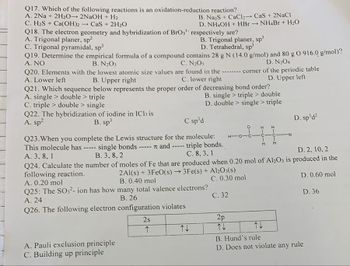
Chemistry
10th Edition
ISBN: 9781305957404
Author: Steven S. Zumdahl, Susan A. Zumdahl, Donald J. DeCoste
Publisher: Cengage Learning
expand_more
expand_more
format_list_bulleted
Concept explainers
Question
Q 19 please

Transcribed Image Text:Q17. Which of the following reactions is an oxidation-reduction reaction?
A. 2Na+ 2H₂O- 2NaOH + H₂
C. H₂S+ Ca(OH)2 -
1 CaS + 2H₂O
Q18. The electron geometry and hybridization of BrO3¹ respectively are?
A. Trigonal planer, sp²
C. Trigonal pyramidal, sp³
B. Trigonal planer, sp³
D. Tetrahedral, sp³
Q19. Determine the empirical formula of a compound contains 28 g N (14.0 g/mol) and 80 g 0 916.0 g/mol)?
A. NO
D. N₂O4
A. single double > triple
C. triple double > single
B. N₂O3
C. N₂O5
Q20. Elements with the lowest atomic size values are found in the -------- corner of the periodic table
A. Lower left
B. Upper right
C. lower right
D. Upper left
Q21. Which sequence below represents the proper order of decreasing bond order?
triple > double
single > triple
Q22. The hybridization of iodine in ICl3 is
A. sp²
B. sp³
B. Na₂S +CaCl2
D. NH4OH + HBr
A. Pauli exclusion principle
C. Building up principle
Q25: The SO3²- ion has how many total valence electrons?
A. 24
B. 26
Q26. The following electron configuration violates
2s
个
B. single
D. double
C sp³d
1-0-1-7
Q23. When you complete the Lewis structure for the molecule:
This molecule has ----- single bonds ----- and ----- triple bonds.
A. 3, 8, 1
B. 3, 8, 2
C. 8, 3, 1
D. 2, 10, 2
Q24. Calculate the number of moles of Fe that are produced when 0.20 mol of Al2O3 is produced in the
following reaction.
2Al(s) + 3FeO(s)→3Fe(s) + Al2O3(s)
B. 0.40 mol
D. 0.60 mol
C. 0.30 mol
A. 0.20 mol
↑↓
CaS + 2NaCl
NH4Br + H₂O
C. 32
2p
↑↓
D. sp³d²
T
D. 36
↑↓
B. Hund's rule
D. Does not violate any rule
Expert Solution
arrow_forward
Step 1
The empirical formula of a chemical compound is the simplest whole number ratio of atoms present in a compound.
Step by stepSolved in 2 steps with 1 images

Knowledge Booster
Learn more about
Need a deep-dive on the concept behind this application? Look no further. Learn more about this topic, chemistry and related others by exploring similar questions and additional content below.Similar questions
- ||| = O MATTER Calculating volume by combining the volume of simple shapes A chemistry student in lab needs to fill a temperature-control tank with water. The tank measures 34.0 cm long by 17.0 cm wide by 14.0 cm deep. In addition, as shown in the sketch below, the student needs to allow 2.0 cm between the top of the tank and the top of the water, and a round-bottom flask with a diameter of 11.5 cm will be just barely submerged in the water. Calculate the volume of water in liters which the student needs. Round your answer to the nearest 0.01 L. Explanation Check 2 cm water X flask 21 OL m stv X 1/3 5 Kirste Ⓒ2023 McGraw Hill LLC. All Rights Reserved. Terms of Use | Privacy Center Acce Sall A O 20 9 Jarrow_forwardcorrect answer please Q6arrow_forward
arrow_back_ios
arrow_forward_ios
Recommended textbooks for you
 ChemistryChemistryISBN:9781305957404Author:Steven S. Zumdahl, Susan A. Zumdahl, Donald J. DeCostePublisher:Cengage Learning
ChemistryChemistryISBN:9781305957404Author:Steven S. Zumdahl, Susan A. Zumdahl, Donald J. DeCostePublisher:Cengage Learning ChemistryChemistryISBN:9781259911156Author:Raymond Chang Dr., Jason Overby ProfessorPublisher:McGraw-Hill Education
ChemistryChemistryISBN:9781259911156Author:Raymond Chang Dr., Jason Overby ProfessorPublisher:McGraw-Hill Education Principles of Instrumental AnalysisChemistryISBN:9781305577213Author:Douglas A. Skoog, F. James Holler, Stanley R. CrouchPublisher:Cengage Learning
Principles of Instrumental AnalysisChemistryISBN:9781305577213Author:Douglas A. Skoog, F. James Holler, Stanley R. CrouchPublisher:Cengage Learning Organic ChemistryChemistryISBN:9780078021558Author:Janice Gorzynski Smith Dr.Publisher:McGraw-Hill Education
Organic ChemistryChemistryISBN:9780078021558Author:Janice Gorzynski Smith Dr.Publisher:McGraw-Hill Education Chemistry: Principles and ReactionsChemistryISBN:9781305079373Author:William L. Masterton, Cecile N. HurleyPublisher:Cengage Learning
Chemistry: Principles and ReactionsChemistryISBN:9781305079373Author:William L. Masterton, Cecile N. HurleyPublisher:Cengage Learning Elementary Principles of Chemical Processes, Bind...ChemistryISBN:9781118431221Author:Richard M. Felder, Ronald W. Rousseau, Lisa G. BullardPublisher:WILEY
Elementary Principles of Chemical Processes, Bind...ChemistryISBN:9781118431221Author:Richard M. Felder, Ronald W. Rousseau, Lisa G. BullardPublisher:WILEY

Chemistry
Chemistry
ISBN:9781305957404
Author:Steven S. Zumdahl, Susan A. Zumdahl, Donald J. DeCoste
Publisher:Cengage Learning

Chemistry
Chemistry
ISBN:9781259911156
Author:Raymond Chang Dr., Jason Overby Professor
Publisher:McGraw-Hill Education

Principles of Instrumental Analysis
Chemistry
ISBN:9781305577213
Author:Douglas A. Skoog, F. James Holler, Stanley R. Crouch
Publisher:Cengage Learning

Organic Chemistry
Chemistry
ISBN:9780078021558
Author:Janice Gorzynski Smith Dr.
Publisher:McGraw-Hill Education

Chemistry: Principles and Reactions
Chemistry
ISBN:9781305079373
Author:William L. Masterton, Cecile N. Hurley
Publisher:Cengage Learning

Elementary Principles of Chemical Processes, Bind...
Chemistry
ISBN:9781118431221
Author:Richard M. Felder, Ronald W. Rousseau, Lisa G. Bullard
Publisher:WILEY